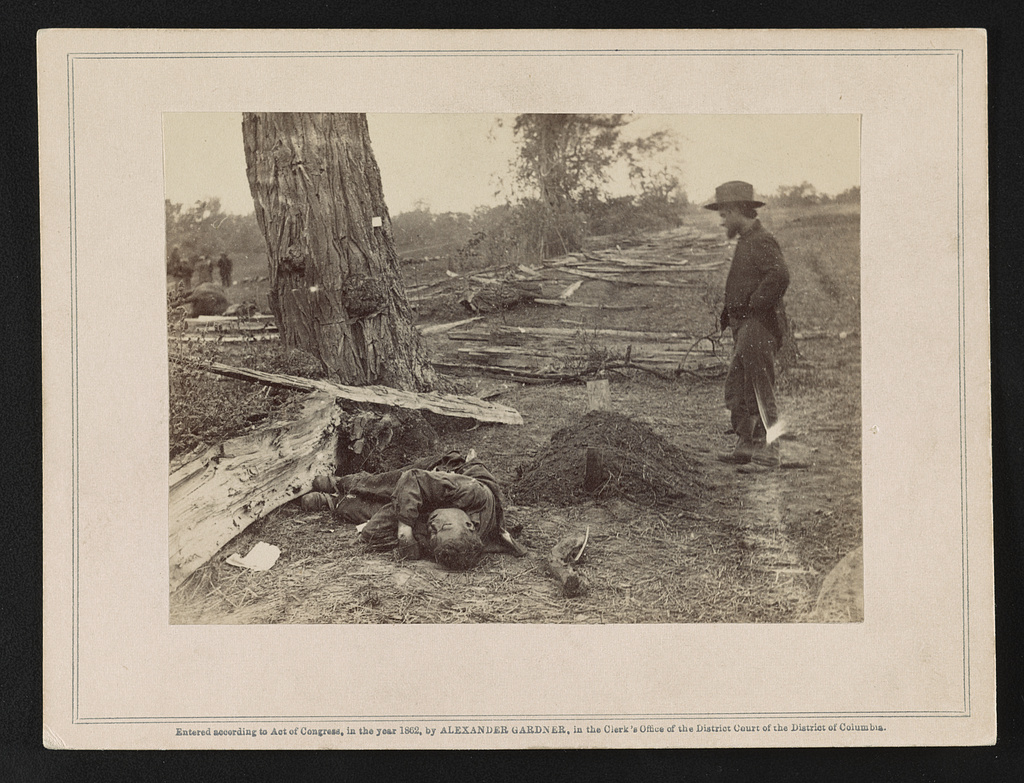The Dead of Antietam

The Dead of Antietam A contrast! Federal buried, rebel unburied, where they fell at the Battle of Antietam, photographed by Alexander Gardner Sept. 1862
Library of Congress Prints and Photographs Division Washington, D.C. 20540
Today is the 153th anniversary of the Battle of Antietam, the bloodiest single-day battle in the history of the United States. In the aftermath of the battle, a strange distinction began to be noted among the Confederate dead.
Clearly, too, does one remember the strangely lifelike position of that dead Confederate soldier sitting astride the stone wall near Wise’s house, his body bent slightly forward, killed just in the act of climbing over; keeping surely more uncanny vigil than did ever sable bird of poet, who
“Perched and sat and nothing more.”
Yet, with the quickly acquired tendency of the soldier to turn anything into a jest, entirely regardless of his own feelings, a Company E boy, noting the well-shod feet of the dead man, exclaimed, “That’s the first rebel I’ve seen with a decent pair of boots on, and by thunder, if he ha’ n’t got up there to show ’em!”
The work of removing and burying the dead went forward with all possible speed, though the rapid digging of so many graves was made extremely difficult by the stony character of the ground. In long windrows they lay, like wheat from the sickle, in fence corners, on the banks, along the sunken road, and beside the stone wall; and regarding this, the historian of the Thirty-fifth Massachusetts says,—
“When the contest had ceased, General Sturgis sent up a section of artillery; and, to let the guns pass, our men moved the wounded and dead from the road upon the bank, sometimes in the darkness placing several bodies together, which led observers in the morning to report to the newspapers that ‘the rebels were piled in heaps as high as the wall.'”
A singular alteration had already become noticeable in the countenances of the Confederate dead, distinguishing them at once from those of the Union troops; they were, without exception, rapidly turning black, so as to make them almost unrecognizable even to their own associates. This curious phenomenon has never been satisfactorily explained, though it continued to be observable throughout the war. Some surgeons conjectured that it might be due to the scarcity of salt in the Confederate army, others laid it to the habit said to be prevalent among them, of mixing gunpowder with their whiskey. Be the reason what it may, it was a sufficiently shocking and painful sight to unaccustomed eyes.
History of the Ninth Regiment New Hampshire Volunteers in the War of the Rebellion, Edward O. Lord, 1895
The notion of consuming gunpowder is the basis for many joke stories of warriors and pugilists who ate gunpowder as a strengthening tonic, then, after death, blew a wall out of the crematorium. I’ve seen vague references to whiskey and gunpowder used as a remedy for man and beast, but never anything definitive. And what about the supposed salt shortage? Could either of these things actually cause a corpse to blacken prematurely?
In 1862 photographer Matthew Brady mounted an exhibit of photographs taken immediately after the Battle of Antietam by Alexander Gardner and James Gibson, whom he had hired. These were the first photographs to show the dead on the field of battle. People flocked to see “The Dead of Antietam,” although there were those who wondered what would happen if someone recognized a loved one among the corpses. These photographs do not seem to show much, if any, unusual discoloration. Possibly the Confederate dead were left unburied longer so decomposition would be more noticeable. Or was this merely a prejudicial way of describing the enemy?
Other thoughts on this phenomenon, which obviously made an impression on the troops and the surgeons?
chriswoodyard8 AT gmail.com
Chris Woodyard is the author of The Victorian Book of the Dead, The Ghost Wore Black, The Headless Horror, The Face in the Window, and the 7-volume Haunted Ohio series. She is also the chronicler of the adventures of that amiable murderess Mrs Daffodil in A Spot of Bother: Four Macabre Tales. The books are available in paperback and for Kindle. Indexes and fact sheets for all of these books may be found by searching hauntedohiobooks.com. Join her on FB at Haunted Ohio by Chris Woodyard or The Victorian Book of the Dead.
